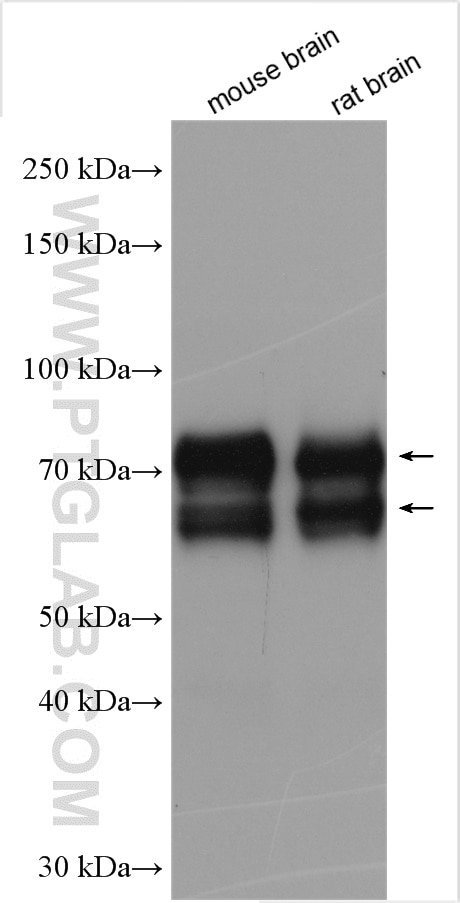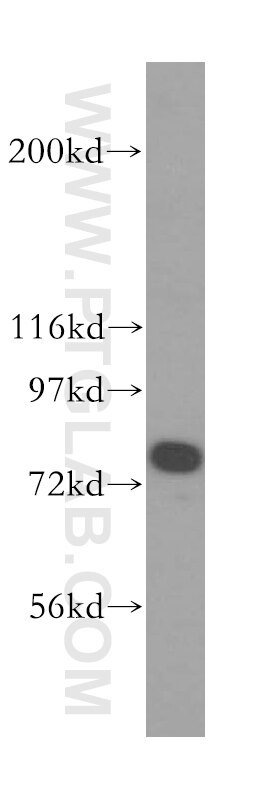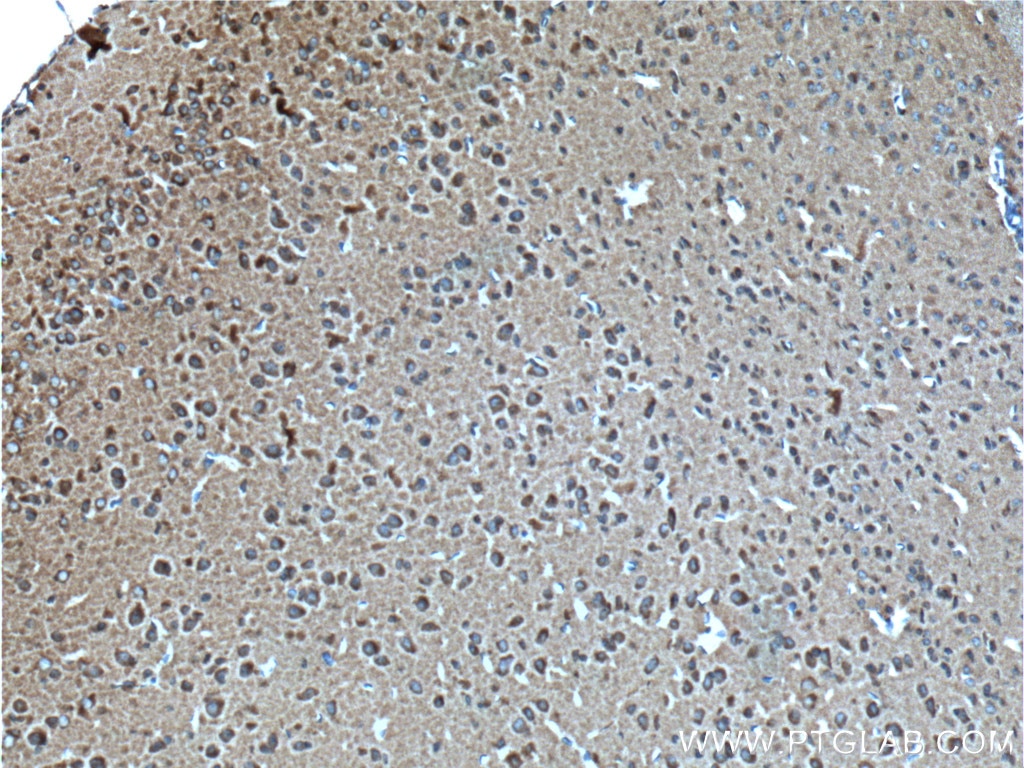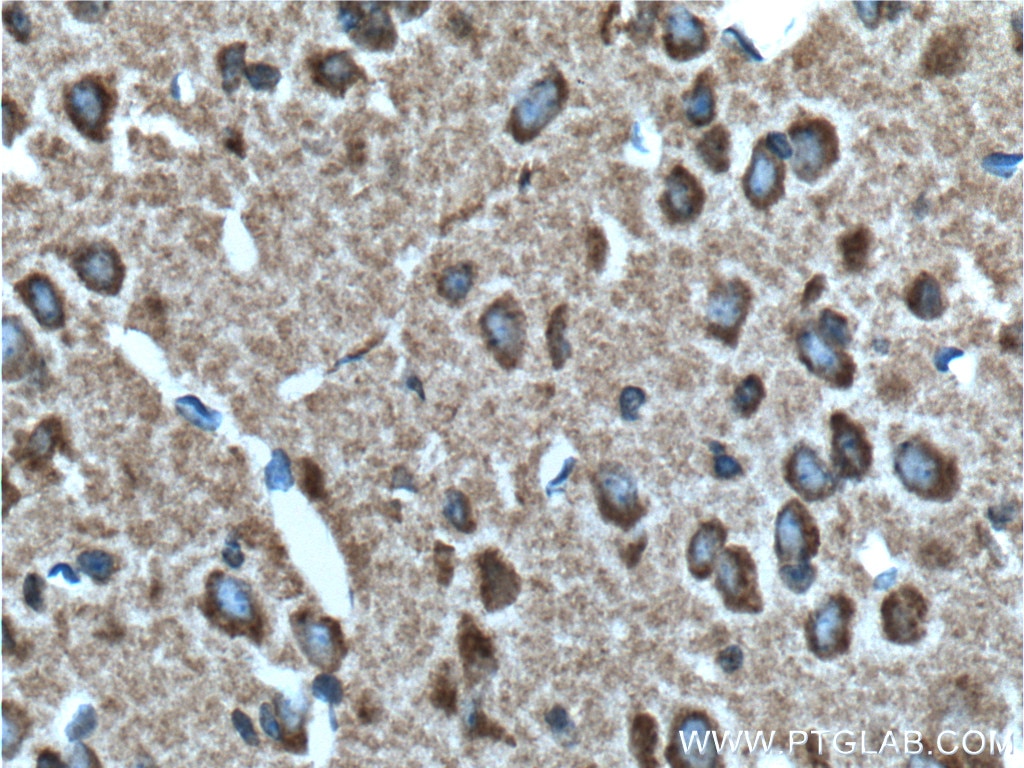Anticorps Polyclonal de lapin anti-Syntaphilin
Syntaphilin Polyclonal Antibody for WB, IHC, ELISA
Hôte / Isotype
Lapin / IgG
Réactivité testée
Humain, rat, souris
Applications
WB, IHC, IF, ELISA
Conjugaison
Non conjugué
N° de cat : 13646-1-AP
Synonymes
Galerie de données de validation
Applications testées
| Résultats positifs en WB | tissu cérébral de souris, tissu cérébral de rat, tissu de trachée de souris |
| Résultats positifs en IHC | tissu cérébral de souris il est suggéré de démasquer l'antigène avec un tampon de TE buffer pH 9.0; (*) À défaut, 'le démasquage de l'antigène peut être 'effectué avec un tampon citrate pH 6,0. |
Dilution recommandée
| Application | Dilution |
|---|---|
| Western Blot (WB) | WB : 1:2000-1:10000 |
| Immunohistochimie (IHC) | IHC : 1:50-1:500 |
| It is recommended that this reagent should be titrated in each testing system to obtain optimal results. | |
| Sample-dependent, check data in validation data gallery | |
Applications publiées
| WB | See 5 publications below |
| IHC | See 2 publications below |
| IF | See 1 publications below |
Informations sur le produit
13646-1-AP cible Syntaphilin dans les applications de WB, IHC, IF, ELISA et montre une réactivité avec des échantillons Humain, rat, souris
| Réactivité | Humain, rat, souris |
| Réactivité citée | rat, Humain, souris |
| Hôte / Isotype | Lapin / IgG |
| Clonalité | Polyclonal |
| Type | Anticorps |
| Immunogène | Syntaphilin Protéine recombinante Ag4594 |
| Nom complet | syntaphilin |
| Masse moléculaire calculée | 538 aa, 58 kDa |
| Poids moléculaire observé | 70-75 kDa, 65 kDa |
| Numéro d’acquisition GenBank | BC035788 |
| Symbole du gène | SNPH |
| Identification du gène (NCBI) | 9751 |
| Conjugaison | Non conjugué |
| Forme | Liquide |
| Méthode de purification | Purification par affinité contre l'antigène |
| Tampon de stockage | PBS with 0.02% sodium azide and 50% glycerol |
| Conditions de stockage | Stocker à -20°C. Stable pendant un an après l'expédition. L'aliquotage n'est pas nécessaire pour le stockage à -20oC Les 20ul contiennent 0,1% de BSA. |
Informations générales
Syntaphilin is a protein selectively expressed in brain. Syntaphilin competes with SNAP-25 for binding to syntaxin-1 and inhibits SNARE complex formation by absorbing free syntaxin-1, and thereby regulates synaptic vesicle exocytosis (PMID: 10707983). The deduced 537-amino acid syntaphilin protein contains an N-terminal proline-rich domain, a predicted coiled-coil domain, a putative C-terminal transmembrane domain, and numerous consensus sites for protein phosphorylation. Whereas the calculated molecular mass of syntaphilin is 58 kDa, the apparent molecular mass of 70-75 kDa is larger than the predicted mass, suggesting a posttranslational modification of syntaphilin (PMID: 9205841; 10707983). An extra band of 65 kDa was also detected by this antibody that may represent an alternative syntaphilin gene product or a stable degradation product (PMID: 10707983; 24457644).
Protocole
| Product Specific Protocols | |
|---|---|
| WB protocol for Syntaphilin antibody 13646-1-AP | Download protocol |
| IHC protocol for Syntaphilin antibody 13646-1-AP | Download protocol |
| Standard Protocols | |
|---|---|
| Click here to view our Standard Protocols |
Publications
| Species | Application | Title |
|---|---|---|
Sci Rep Identification of a novel interaction of FUS and syntaphilin may explain synaptic and mitochondrial abnormalities caused by ALS mutations. | ||
Mol Brain Disrupted-in-schizophrenia 1 (DISC1) and Syntaphilin collaborate to modulate axonal mitochondrial anchoring. | ||
Brain Res Miro1 provides neuroprotection via the mitochondrial trafficking pathway in a rat model of traumatic brain injury. | ||
Bioeng Transl Med Photobiomodulation augments the effects of mitochondrial transplantation in the treatment of spinal cord injury in rats by facilitating mitochondrial transfer to neurons via Connexin 36 | ||
Neuroscience Armcx1 reduces neurological damage via a mitochondrial transport pathway involving Miro1 after traumatic brain injury | ||
Neurochem Int 3-Nitrotyrosine shortens axons of non-dopaminergic neurons by inhibiting mitochondrial motility |





